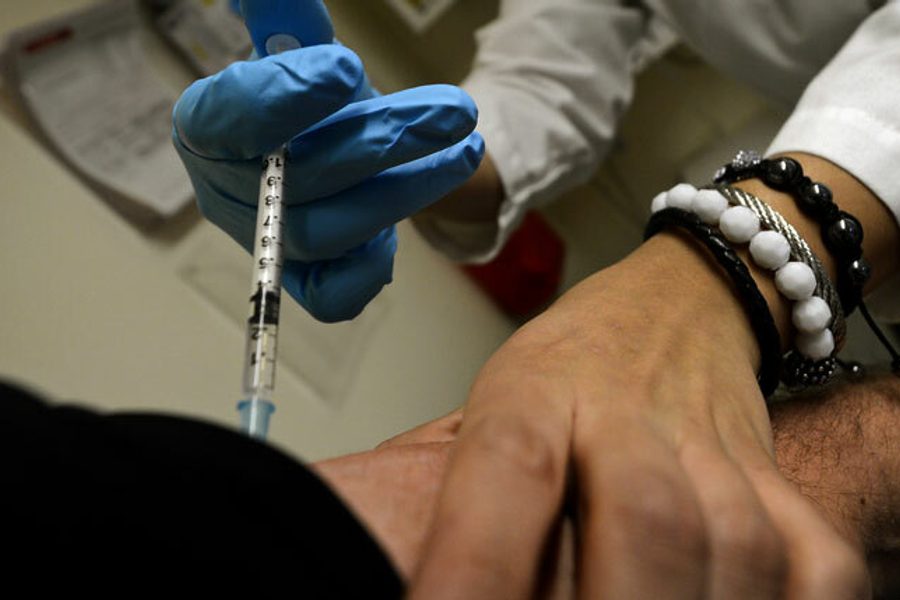A Flu Shot in the Dark
Does 9 percent success rate in the elderly justify universal vaccination?
Terry J. Allen

Type “Are flu shots dangerous?” into Google and tinfoil hats will dance across your screen. People distrust vaccinations for reasons ranging from the paranoid (they cause autism and diabetes) to the quasi-religious (a “natural” approach is always better).
And then there is healthy skepticism of vaccines because they are made and marketed by a pharmaceutical industry notorious for shilling useless or harmful products approved by underfunded or corrupted government agencies.
If you are hoping for a screed against vaccination, you’ll have more luck on such nutter websites as the funny-if-it-wasn’t-dangerous NaturalNews.com. What we need isn’t no vaccines, but better vaccines.
Many people, and much of the media, were surprised by recent reports that the 2012-13 flu vaccine protected only 9 percent of the elderly. That news went against conventional wisdom that flu shots work most of the time for most people. And therein lies a public health danger. By overselling flu shots as more effective that they actually are, BigPharma and government regulatory agencies create “substantial backlash and mistrust” in an already skeptical public, the University of Minnesota’s Center for Infectious Disease Research and Policy (CIDRAP) concluded. Government programs to vaccinate everyone against the flu — including populations with low risk of flu complications, or who are unlikely to benefit from flu shots — support a profitable status quo that “dampens serious investment and shuts down any real interest in start-ups to create a more effective vaccine,” CIDRAP researcher Michael Osterholm told CNN. Without a new approach, odds are that when a really lethal flu strain hits, we will be ill-prepared to prevent widespread infection.
Vaccines against smallpox, polio, tetanus and a variety of childhood diseases have saved a huge number of lives. Every year, vaccination prevents more than 2.5 million deaths from infectious childhood diseases. Many childhood vaccines have 95 percent effectiveness and confer multi-year or even lifetime immunity; very few have serious side effects.
But flu shots, even at their best — in a year when the vaccine is a good match for the most prevalent viruses — have only “a modest effect in reducing influenza symptoms and working days lost,” concluded the Cochrane Collaboration, an international network of experts, after analyzing 50 studies involving 80,000 people. “There is no evidence that [flu shots] affect complications, such as pneumonia, ortransmission.” In another report, Cochrane found that, for kids between 6 months and 2 years old, flu shots “are not significantly more efficacious than placebo.”
For people 65 or older, a group particularly vulnerable to serious complications, flu shots have not reduced “influenza-related mortality,” according to the Archives of Internal Medicine. The reason is “immune senescence”: Older people generally do not react to vaccinations by producing enough antibodies to induce immunity.
Those are statistics, not hard-and-fast rules, and if you happen to be one of the tiny percent of frail elderly for whom the flu vaccine works, it may indeed save much suffering and possibly your life.
But while getting a flu shot may be a reasonable individual decision, that does not mean that making flu shots universal is a valid public health priority. Since the flu virus rapidly mutates, vaccines have to be reformulated and administered annually, and even then provide only limited protection to limited populations.
Given U.S. taxpayers’ multi-billion-dollar contribution to developing and promoting flu vaccines, and the industry’s multi-billion-dollar profits, the results are less than fabulous: This year’s flu shot protected just over half of U.S. recipients; flu still infected 5 to 20 percent of Americans, hospitalized more than 200,000 and killed thousands.
The U.S. and Canada are among a very few countries to recommend universal flu vaccination for everyone older than 6 months. One factor in the U.S. shotgun approach may be the influence of the CDC’s Advisory Committee on Immunization Practices (ACIP). “Most ACIP members, if not all, have ties to vaccine makers, such that the CDC must grant them waivers from statutory conflict of interest rules,” according to industry website Bionity.com.
From 1999 through 2010 — pushing aside unanswered questions about effectiveness and the safety of repeated doses — ACIP advocated for including more and more subgroups, and led the CDC to recommend universal vaccination.
The CDC-ACIP strategy of universal flu vaccination relies on two flawed assertions: that flu shots are very effective, and that broader vaccination promotes herd immunity — the idea that, when almost all people are immune, the chain of infection is broken and the rest, despite being unvaccinated, are safe. The first premise is wrong — effectiveness varies widely by age and how well the vaccine fits the year’s strains. The second, “herd immunity,” only holds when a vaccine actually protects 85-95 percent of the “herd.”
Until there is a better vaccine, the U.S. might look to how Europe and Japan protect their own “herds.” In Japan, when people who feel sick go out in public, they routinely don a facemask as a common courtesy to prevent infecting others. In many Western European countries, a side effect of decent social policies is fewer contagious people out and about, spreading germs. Widespread paid family and medical leave allows symptomatic workers and students to stay home until the flu runs its course, which for healthy people usually takes a week or so.
“Vaccines are subject to a winner’s curse,” the journal Health Affairs notes. “The longer the efficacy, the smaller the demand.” Flu vaccines avoid the curse by having a one-year life cycle. This pattern has allowed the flu vaccine industry to run in place for 60 years: At the end of each winter, a global group overseen by the World Health Organization predicts next season’s likely strains, and manufacturers begin incubating a customized vaccine in hundreds of millions of chicken eggs. Some years the researchers pick well, but in other years the vaccines fail to match the season’s worst or most prevalent strains.
But whether or not flu vaccines are well-chosen and effective, their manufacturers enjoy fairly constant and reliable profits — not the blockbuster earnings of erectile dysfunction pills or diabetes meds or high blood-pressure drugs (which treat but never cure), but still, what the New York Times labeled a “bonanza.”
Since 1990 more than 1 billion doses of flu vaccine have been administered in the United States. This season the CDC spent more than $150 million on flu vaccinations, and 145 million doses were available. With steady sales, reliable profits and government promotion of universal flu shots, producers have little incentive to make the billion-dollar, multi-year investment necessary to develop a revolutionary, game-changing vaccine that would span strains and last years, and, if the “winner’s curse” applies, bring less profit.
So the annual game continues, sponsored in part by a pharmaceutical industry whose profit-seeking can eclipse good public health policy. Many of the trials showing flu vaccine effectiveness were funded by the vaccine companies themselves, and even well-intentioned researchers who rely on these data may create “an optimistic estimate because company-sponsored influenza vaccine trials tend to produce results favorable to their products,” the Cochrane Collaboration determined.
“Reliable evidence on influenza vaccines is thin, but there is evidence of widespread manipulation of conclusions and spurious notoriety of the studies,” tainted by the CDC’s habit of cherry-picking data.
So, should you get a flu vaccine every year? Damned if I know. It may or may not work, but it is a largely safe and rational choice, especially if you are in, or have contact with, high-risk groups. Is the CDC promotion of universal flu shots good public-health policy and a wise use of government resources and credibility? Much evidence points to no.
Should we push for healthcare policies that promote a more effective approach to flu vaccination, paid sick and family leave, and a restructuring of government oversight to avoid drug company influence? Oh, yes.









